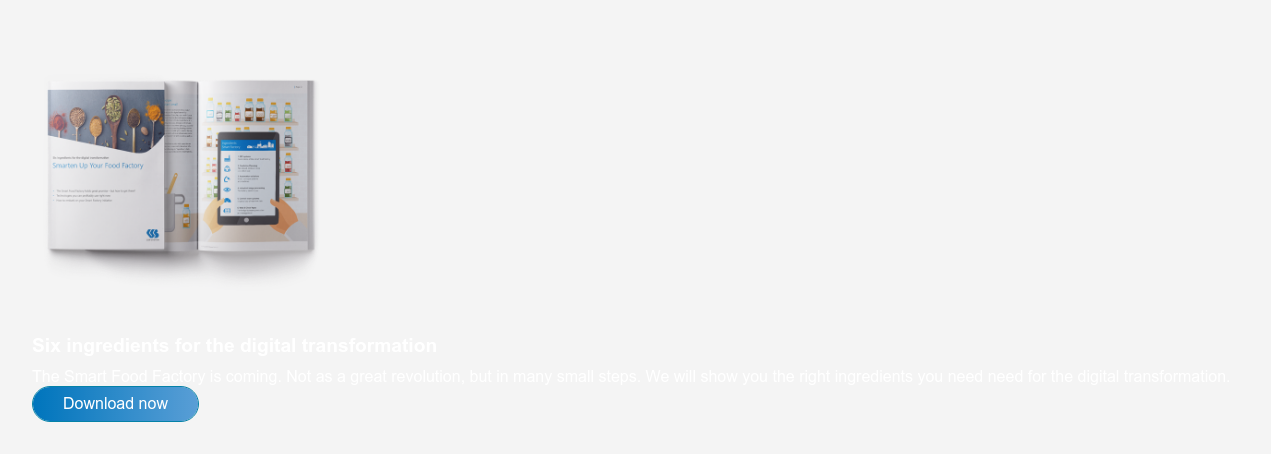Networked packaging systems, robot technology in the warehouse, forward-looking planning: The digitization of the food industry has made great progress. The following motto now applies to food producers: Let's get going. With these six technologies, you can take advantage of the Smart Factory today.
ERP systems especially for the factory
Modern ERP systems are essential in the technology landscape of the Smart Factory. It is only through them that continuous digitalization becomes possible at all. The ERP system is the integration hub that connects everything: employees, IT systems, machines, and sensors, but also vendors and customers. The prerequisite for this is that the system was specially developed for the requirements of food production. Not only can classic processes such as cost and recipe management, sales and production planning be optimally supported, but machines can also be networked, systems controlled and the information flows between all human and technical players are efficiently organized. The bottom line is that ERP systems provide the advantages that are decisive in the food industry: fast processes from ordering through production and logistics to provision on the shelf.
Are you looking for a new ERP system? Read our blog article to find out what to look out for when selecting an ERP system.
Control room systems
The new generation of control room systems is also helpful for the digital transformation to a smart food producer. They ensure higher operational efficiency through forward-looking control and maintenance of machines and systems. Key operating and condition data, for example from packaging machines they are digitally recorded, aggregated and analyzed. This enables correlations between machine malfunctions and load parameters to be detected immediately, enabling maintenance work to be carried out early and on schedule and costly downtimes to be avoided.
An example: With its new control room solution, meat and sausage producer Wolf can optimize the overall system effectiveness of its machines and systems. The solution provides real-time data on the current utilization and performance of machines and plants.
Predictive planning
There is no magic formula for dealing with digitalization, but there are some practical tips. The most important one is: It is better to improve existing processes in small steps than to take a very big leap directly. Why not start at the planning stage? Predictive production planning systems are already capable of integrating the growing variety of variants, increasing volatility or even “same day delivery” requirements into the planning scenarios. This way, raw materials and supplies can be optimally planned, set-up times minimized, bottlenecks avoided, and short-term changes sensibly implemented. Even the smallest batches can be produced efficiently and cost-effectively. Read more about production planning here: Complete solution vs. Best of Breed.
Web and Cloud apps
If you want to be smart, you need decision-relevant information. The decentralized provision of information thus becomes a success factor in food production: Web and cloud-based apps monitor and control the entire production process and deliver dashboards of business figures, sales figures or production KPIs - on PC, tablet or smartphone. Important information is thus generated and provided where the added value takes place or where the employees need it: at the incoming goods department, in production, during order picking, on-site at the customer - or comfortably on the couch at home.
Industrial image processing
In a smart factory, it is no longer just a matter of efficiently recording and processing data. The data potential is only properly used when the data is evaluated directly in the process and actions such as sorting raw materials or finished products can be automated. Industrial image processing is a key technology for this. It offers great efficiency gains wherever the human eye reaches its limits in the quantitative measurement of structured events. In addition to quality assurance, industrial image processing also improves the efficiency of processes and the quality of information processing.
Automation solutions
The automation of individual processes or entire areas in production and logistics opens up many possibilities for food producers to operate more efficiently. This requires a homogeneous IT infrastructure, intelligent data management and a smart workflow in order to manage, monitor, optimize and automate all processes accordingly. Whether fully automated production lines, semi-automated order picking systems or even robot-controlled dispatch warehouses: Many current practical examples show what effect automated processes can have. In addition to cost leadership, newer solutions also offer greater flexibility. Why the decoupling of process steps is becoming increasingly important is explained in our practical example ProMessa.
Conclusion: Orientated towards real-life scenarios
All in all, there are many interesting technologies for the establishment of Smart Food Factories. Now it's time to get started. For a successful start into the digital transformation, it is most promising to orientate oneself to established real-life scenarios and to set standards. Because even if digitalization pioneers such as Amazon, Facebook or Uber exert great fascination: For companies in the food industry, they are at most a trigger for tackling digital change. The most important thing is to learn to master the new complexity step by step while concentrating on best practices. Then improvements in production or logistic processes can be made quickly and without great risk.


